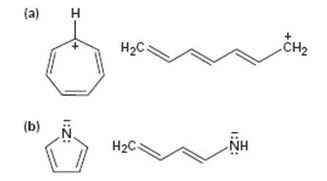
Organic Chemistry
9th Edition
ISBN: 9781305080485
Author: John E. McMurry
Publisher: Cengage Learning
expand_more
expand_more
format_list_bulleted
Textbook Question
Chapter 15.SE, Problem 53AP
Consider the

Expert Solution & Answer
Want to see the full answer?
Check out a sample textbook solution
Students have asked these similar questions
When talking about the acidity of carboxylic acids, is it the same thing to say higher or stronger acidity?
Using the following two half-reactions, determine the pH range in which $NO_2^-\ (aq)$ cannot be found as the predominant chemical species in water.* $NO_3^-(aq)+10H^+(aq)+8e^-\rightarrow NH_4^+(aq)+3H_2O(l),\ pE^{\circ}=14.88$* $NO_2^-(aq)+8H^+(aq)+6e^-\rightarrow NH_4^+(aq)+2H_2O(l),\ pE^{\circ}=15.08$
Indicate characteristics of oxodec acid.
Chapter 15 Solutions
Organic Chemistry
Ch. 15.1 - Prob. 1PCh. 15.1 - Give IUPAC names for the following compounds:Ch. 15.1 - Prob. 3PCh. 15.2 - Pyridine is a flat, hexagonal molecule with bond...Ch. 15.3 - Prob. 5PCh. 15.4 - Draw the five resonance structures of the...Ch. 15.4 - Prob. 7PCh. 15.4 - Prob. 8PCh. 15.5 - Prob. 9PCh. 15.5 - Prob. 10P
Ch. 15.6 - Prob. 11PCh. 15.6 - How many electrons does each of the four nitrogen...Ch. 15.SE - Give IUPAC names for the following substances (red...Ch. 15.SE - All-cis cyclodecapentaene is a stable molecule...Ch. 15.SE - 1, 6-Methanonaphthalene has an interesting 1H NMR...Ch. 15.SE - Prob. 16VCCh. 15.SE - Azulene, an isomer of naphthalene, has a...Ch. 15.SE - Give IUPAC names for the following compounds:Ch. 15.SE - Draw structures corresponding to the following...Ch. 15.SE - Prob. 20APCh. 15.SE - Prob. 21APCh. 15.SE - Draw and name all possible aromatic compounds with...Ch. 15.SE - Propose structures for aromatic hydrocarbons that...Ch. 15.SE - Look at the three resonance structures of...Ch. 15.SE - Prob. 25APCh. 15.SE - Prob. 26APCh. 15.SE - Look at the five resonance structures for...Ch. 15.SE - Prob. 28APCh. 15.SE - 3-Chlorocyclopropene, on treatment with AgBF4,...Ch. 15.SE - Prob. 30APCh. 15.SE - Prob. 31APCh. 15.SE - Prob. 32APCh. 15.SE - Which would you expect to be most stable,...Ch. 15.SE - How might you convert 1, 3, 5, 7-cyclononatetraene...Ch. 15.SE - Calicene, like azulene (Problem 15-17), has an...Ch. 15.SE - Pentalene is a most elusive molecule that has been...Ch. 15.SE - Prob. 37APCh. 15.SE - Prob. 38APCh. 15.SE - Compound A, C8H10, yields three substitution...Ch. 15.SE - Prob. 40APCh. 15.SE - Propose structures for compounds that fit the...Ch. 15.SE - Prob. 42APCh. 15.SE - Prob. 43APCh. 15.SE - N-Phenylsydnone, so-named because it was first...Ch. 15.SE - Prob. 45APCh. 15.SE - Prob. 46APCh. 15.SE - Prob. 47APCh. 15.SE - Propose a structure for a molecule C14H12 that has...Ch. 15.SE - The proton NMR spectrum for a compound with...Ch. 15.SE - The proton NMR spectrum of a compound with formula...Ch. 15.SE - Aromatic substitution reactions occur by addition...Ch. 15.SE - Prob. 52APCh. 15.SE - Consider the aromatic anions below and their...Ch. 15.SE - After the reaction below, the chemical shift of Ha...Ch. 15.SE - Prob. 55APCh. 15.SE - Azo dyes are the major source of artificial color...
Knowledge Booster
Learn more about
Need a deep-dive on the concept behind this application? Look no further. Learn more about this topic, chemistry and related others by exploring similar questions and additional content below.Similar questions
- What is the final product when hexanedioic acid reacts with 1º PCl5 and 2º NH3.arrow_forwardWhat is the final product when D-galactose reacts with hydroxylamine?arrow_forwardIndicate the formula of the product obtained by reacting methyl 5-chloro-5-oxopentanoate with 1 mole of 4-penten-1-ylmagnesium bromide.arrow_forward
- The temperature on a sample of pure X held at 1.25 atm and -54. °C is increased until the sample boils. The temperature is then held constant and the pressure is decreased by 0.42 atm. On the phase diagram below draw a path that shows this set of changes. pressure (atm) 2 0 0 200 400 temperature (K) Xarrow_forwardQUESTION: Answer Question 5: 'Calculating standard error of regression' STEP 1 by filling in all the empty green boxes *The values are all provided in the photo attached*arrow_forwardpressure (atm) 3 The pressure on a sample of pure X held at 47. °C and 0.88 atm is increased until the sample condenses. The pressure is then held constant and the temperature is decreased by 82. °C. On the phase diagram below draw a path that shows this set of changes. 0 0 200 temperature (K) 400 аarrow_forward
arrow_back_ios
SEE MORE QUESTIONS
arrow_forward_ios
Recommended textbooks for you
 Organic Chemistry: A Guided InquiryChemistryISBN:9780618974122Author:Andrei StraumanisPublisher:Cengage Learning
Organic Chemistry: A Guided InquiryChemistryISBN:9780618974122Author:Andrei StraumanisPublisher:Cengage Learning

Organic Chemistry: A Guided Inquiry
Chemistry
ISBN:9780618974122
Author:Andrei Straumanis
Publisher:Cengage Learning

SAR of Anticancer(Antineoplastic) Drug/ Alkylating agents/ Nitrogen Mustard; Author: Pharmacy Lectures;https://www.youtube.com/watch?v=zrzyK3LhUXs;License: Standard YouTube License, CC-BY